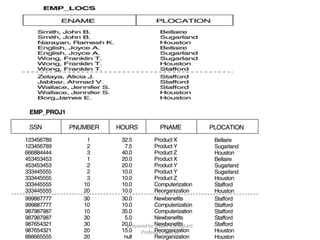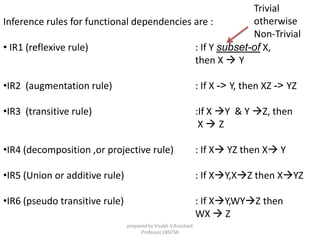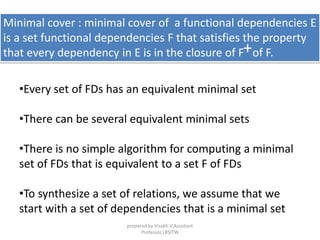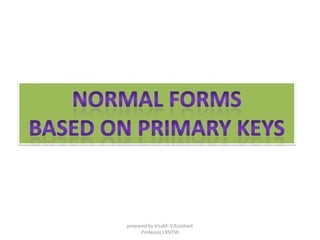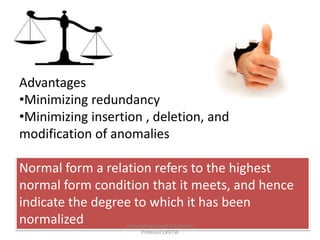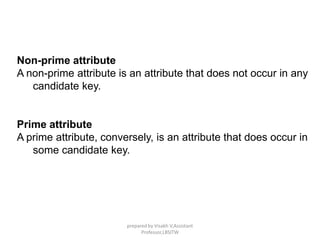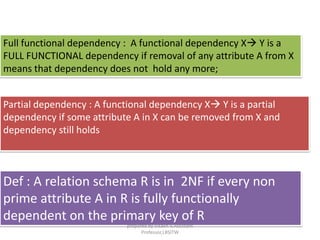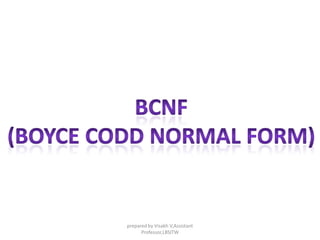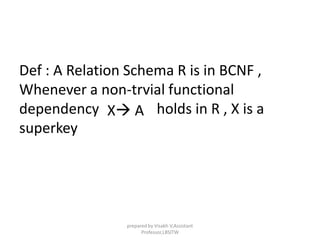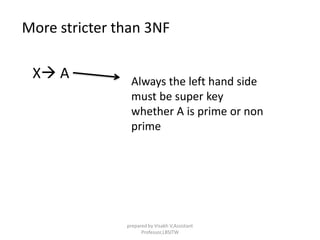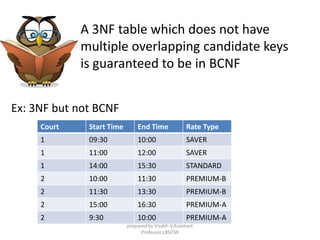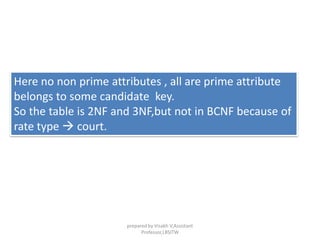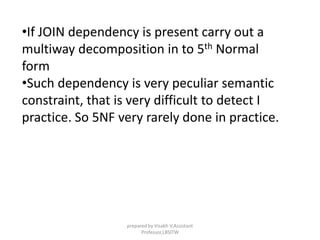Functional dependency and normalization
- 1. Functional Dependencies prepared by Visakh V,Assistant Professor,LBSITW
- 2. There are two levels at which we discuss the goodness of relation schema •Logical (or Conceptual)Level •Implementation (or storage ) Level prepared by Visakh V,Assistant Professor,LBSITW
- 3. prepared by Visakh V,Assistant Professor,LBSITW
- 4. 4 Informal measures of quality for relation schemas are I. Semantics of the attribute • interpretation of attribute values from tuples • The attribute belonging to one relation have certain real-world meaning and a proper interpretation associated with them prepared by Visakh V,Assistant Professor,LBSITW
- 5. ii. Reducing redundant information in tuples • minimize the storage space used by the base relation • Problem of update anomalies • Insertion of anomalies • Deletion of anomalies • Modification of anomalies iii. Reducing the NULL values in the tuples • Waste space at storage levels • Also lead to problems with understanding the meaning of attributes (ex:count,join ) iv. Disallowing the possibility of generating spurious tuples • Seems to be genuine but it is falseprepared by Visakh V,Assistant Professor,LBSITW
- 6. prepared by Visakh V,Assistant Professor,LBSITW
- 7. prepared by Visakh V,Assistant Professor,LBSITW
- 8. prepared by Visakh V,Assistant Professor,LBSITW
- 9. • Most important concept in relational schema design theory. • A functional dependency is a constraint between two set of attributes from the database. • it is denoted by X Y(functional dependency from x to y or y is functionally dependent on X.) • i.e. Y component of a tuple in r depend on , or are determined by , the values of the Y component. •A functional dependency is a property of the of the semantics or meaning .prepared by Visakh V,Assistant Professor,LBSITW
- 10. prepared by Visakh V,Assistant Professor,LBSITW
- 11. Inference ??? •Dept_no Mgr_SSN , each department has one manager • Mgr_SSN Mgr_phone : Each manager has a unique phone number • then we can infer Dept_no Mgr_phone prepared by Visakh V,Assistant Professor,LBSITW
- 12. Closure : includes all dependencies that can be inferred from the given set F, it is denoted by F closure ??? + Let us see some examples on board prepared by Visakh V,Assistant Professor,LBSITW
- 13. The notation F XY means the functional dependency XY is inferred from functional dependencies F. To determine a systematic way to infer dependencies, we use inference rules that can be used to infer new dependencies prepared by Visakh V,Assistant Professor,LBSITW
- 14. Inference rules for functional dependencies are : • IR1 (reflexive rule) : If Y subset-of X, then X Y •IR2 (augmentation rule) : If X -> Y, then XZ -> YZ •IR3 (transitive rule) :If X Y & Y Z, then X Z •IR4 (decomposition ,or projective rule) : If X YZ then X Y •IR5 (Union or additive rule) : If XY,XZ then XYZ •IR6 (pseudo transitive rule) : If XY,WYZ then WX Z Trivial otherwise Non-Trivial prepared by Visakh V,Assistant Professor,LBSITW
- 15. Inference rules IR1 through IR3 are sound and complete Dependency that we can infer from F by using IR1 to IR3 holds every relation state r of R that satisfies the dependencies in F. Using IR1to IR3 repeatedly to infer dependencies until no more dependencies can be inferred from F The closure of F , can be determined from F by using inference rules IR1 to IR3 are known as Armstrong ‘s inference rules. prepared by Visakh V,Assistant Professor,LBSITW
- 16. prepared by Visakh V,Assistant Professor,LBSITW
- 17. Cover : A set of functional dependencies F is said to cover another set of dependencies E if every FD in E is also in F . Or we can say that E is covered by F. + Two sets of functional dependencies E and F are equivalent if E = F .+ + prepared by Visakh V,Assistant Professor,LBSITW
- 18. prepared by Visakh V,Assistant Professor,LBSITW
- 19. Minimal cover : minimal cover of a functional dependencies E is a set functional dependencies F that satisfies the property that every dependency in E is in the closure of F of F.+ •Every set of FDs has an equivalent minimal set •There can be several equivalent minimal sets •There is no simple algorithm for computing a minimal set of FDs that is equivalent to a set F of FDs •To synthesize a set of relations, we assume that we start with a set of dependencies that is a minimal set prepared by Visakh V,Assistant Professor,LBSITW
- 20. • Set F:= E • Replace each functional dependencies X{A1,A2,. . . .,An} in F by the n functional dependencies X A1,XA2,. .. .,XAn. • For each functional dependencies X A in For each attribute B that is an element of X • if {F – {XA}} U {(x-{B}) a} } Algorithm Finding a Minimal cover F for a set of functional dependencies E CANONICAL formprepared by Visakh V,Assistant Professor,LBSITW
- 21. Find minimum cover for E {B A, DA,ABD} Find minimum cover for E {AD,BCA,BCD,CB,EA,ED} Find minimum cover for E { AB -> C, C -> A, BC -> D, ACD -> B, D -> E, D -> G, BE -> C, CG -> B, CG -> D, CE -> A, CE -> G} prepared by Visakh V,Assistant Professor,LBSITW
- 22. Find minimum cover for E {noname noage no,nameage noage,name} prepared by Visakh V,Assistant Professor,LBSITW
- 23. NORMAL FORMS prepared by Visakh V,Assistant Professor,LBSITW
- 24. prepared by Visakh V,Assistant Professor,LBSITW
- 25. •First proposed by Codd (1972) •Initially proposed first ,second and 3NF • later Boyce and Codd proposed BCNF • later 4th and 5th NF are proposed based on the concept of multi- valued dependency and join dependencies prepared by Visakh V,Assistant Professor,LBSITW
- 26. Advantages •Minimizing redundancy •Minimizing insertion , deletion, and modification of anomalies Normal form a relation refers to the highest normal form condition that it meets, and hence indicate the degree to which it has been normalized prepared by Visakh V,Assistant Professor,LBSITW
- 27. Non-prime attribute A non-prime attribute is an attribute that does not occur in any candidate key. Prime attribute A prime attribute, conversely, is an attribute that does occur in some candidate key. prepared by Visakh V,Assistant Professor,LBSITW
- 28. prepared by Visakh V,Assistant Professor,LBSITW
- 29. •Disallow multi valued attributes and composite attributes • it states that domain of an attributes must include only atomic (simple, indivisible)values. •Ex: address prepared by Visakh V,Assistant Professor,LBSITW
- 30. prepared by Visakh V,Assistant Professor,LBSITW
- 31. Partial key prepared by Visakh V,Assistant Professor,LBSITW
- 32. Must be in 1NF prepared by Visakh V,Assistant Professor,LBSITW
- 33. Full functional dependency : A functional dependency X Y is a FULL FUNCTIONAL dependency if removal of any attribute A from X means that dependency does not hold any more; Partial dependency : A functional dependency X Y is a partial dependency if some attribute A in X can be removed from X and dependency still holds Def : A relation schema R is in 2NF if every non prime attribute A in R is fully functionally dependent on the primary key of R prepared by Visakh V,Assistant Professor,LBSITW
- 34. prepared by Visakh V,Assistant Professor,LBSITW
- 35. prepared by Visakh V,Assistant Professor,LBSITW
- 36. •it must be in 2NF Def : A Relation Schema R is in 3nF , Whenever a non-trivial functional dependency holds in R ,either (a)X is a super key of R or (b) A is a prime attribute of R X A prepared by Visakh V,Assistant Professor,LBSITW
- 37. X A If A is non prime attribute then X must be super key prepared by Visakh V,Assistant Professor,LBSITW
- 38. prepared by Visakh V,Assistant Professor,LBSITW
- 39. Def : A Relation Schema R is in BCNF , Whenever a non-trvial functional dependency holds in R , X is a superkey X A prepared by Visakh V,Assistant Professor,LBSITW
- 40. More stricter than 3NF X A Always the left hand side must be super key whether A is prime or non prime prepared by Visakh V,Assistant Professor,LBSITW
- 41. Here {student, course instructor} {instructor course} It is 3NF but not BCNF prepared by Visakh V,Assistant Professor,LBSITW
- 42. In BCNF must check TWO conditions • X Y allowed ,if it is trivial functional dependency OR • X is a super key for schema R BCNF is More stricter than 3NF prepared by Visakh V,Assistant Professor,LBSITW
- 43. A 3NF table which does not have multiple overlapping candidate keys is guaranteed to be in BCNF Ex: 3NF but not BCNF Court Start Time End Time Rate Type 1 09:30 10:00 SAVER 1 11:00 12:00 SAVER 1 14:00 15:30 STANDARD 2 10:00 11:30 PREMIUM-B 2 11:30 13:30 PREMIUM-B 2 15:00 16:30 PREMIUM-A 2 9:30 10:00 PREMIUM-A prepared by Visakh V,Assistant Professor,LBSITW
- 44. Here the candidate keys are S1: {COURT,START TIME} S2:{COURT,END TIME} S3:{RATE TYPE,START TIME} S4:{RATE TYPE, END TIME} Here no non prime attributes , all are prime attribute belongs to some candidate key. So the table is 2NF and 3NF.but not in BCNF.prepared by Visakh V,Assistant Professor,LBSITW
- 45. Here no non prime attributes , all are prime attribute belongs to some candidate key. So the table is 2NF and 3NF,but not in BCNF because of rate type court. prepared by Visakh V,Assistant Professor,LBSITW
- 46. Today's Bookings Rate Type Start Time End Time SAVER 09:30 10:30 SAVER 11:00 12:00 STANDARD 14:00 15:30 PREMIUM-B 10:00 11:30 PREMIUM-B 11:30 13:30 PREMIUM-A 15:00 16:30 Rate Types Rate Type Court Member Flag SAVER 1 Yes STANDARD 1 No PREMIUM-A 2 Yes PREMIUM-B 2 No Now it is in BCNF prepared by Visakh V,Assistant Professor,LBSITW
- 47. Problems when using BCNF Person Shop Type Nearest Shop Teena Optician Eagle Eye Meenu Hairdresser Snippets Priya Bookshop Merlin Books Sreedevi Bakery Sree bakers Sreedevi Hairdresser Sweeney Sreedevi Optician Eagle Eye Dependency: A, B C C B Not BCNFprepared by Visakh V,Assistant Professor,LBSITW
- 48. Shop Near Person Person Shop Teena Eagle Eye Meenu Snippets Priya Merlin Books Sreedevi Sree Bakers Sreedevi Sweeney Sreedevi Eagle Eye Shop Shop Shop Type Eagle Eye Optician Snippets Hairdresser Merlin Books Bookshop Sree Bakers Bakery Sweeney Hairdresser prepared by Visakh V,Assistant Professor,LBSITW
- 49. Problem : It allow us to record data such as,a person’s multiple shops with same type ,It violates the dependency {person,shoptype}{shop} So BCNF is not always possible prepared by Visakh V,Assistant Professor,LBSITW
- 50. (Lets do some problems) prepared by Visakh V,Assistant Professor,LBSITW
- 51. prepared by Visakh V,Assistant Professor,LBSITW
- 52. MULTIVALUED DEPENDENCY : A consequence of first normal form, Which disallows an attribute have a set of values : A multivalued dependency is a special case of a join dependency, Course Book Lecturer AHA Silberschatz John D AHA Nederpelt William M AHA Silberschatz William M AHA Nederpelt John D AHA Silberschatz Christian G AHA Nederpelt Christian G OSO Silberschatz John D OSO Silberschatz William M {course} {book} and equivalently {course} {lecturer}. prepared by Visakh V,Assistant Professor,LBSITW
- 53. Definition for 4th Normal Form A relation schema R is in 4NF with respect to a set of dependencies F (that include functional dependencies and multivalued dependencies ),if for every non trivial multivalued dependency X Y in F closure,X is a super key of R. A trivial multivalued dependency X Y is one where either Y is a subset of X, or X and Y together form the whole set of attributes of the relation. prepared by Visakh V,Assistant Professor,LBSITW
- 54. prepared by Visakh V,Assistant Professor,LBSITW
- 55. prepared by Visakh V,Assistant Professor,LBSITW
- 56. prepared by Visakh V,Assistant Professor,LBSITW
- 57. prepared by Visakh V,Assistant Professor,LBSITW
- 58. •In dependency theory, a join dependency is a constraint on the set of legal relations over a database scheme. • A table T is subject to a join dependency if T can always be recreated by joining multiple tables each having a subset of the attributes of T. • If one of the tables in the join has all the attributes of the table T, the join dependency is called trivial prepared by Visakh V,Assistant Professor,LBSITW
- 59. •If JOIN dependency is present carry out a multiway decomposition in to 5th Normal form •Such dependency is very peculiar semantic constraint, that is very difficult to detect I practice. So 5NF very rarely done in practice. prepared by Visakh V,Assistant Professor,LBSITW
- 60. NON ADDITIVE (LOSELESS) JOIN DEPENDENCY •Which ensures that no spurious tuples are generated when a NATURAL JOIN operation is applied to the relations in the decomposition • lossless refers to loss information ,not to loss of tuples. prepared by Visakh V,Assistant Professor,LBSITW
- 61. Example of lossy decomposition A B C 1 1 1 1 1 2 1 2 1 A B C 1 1 1 1 1 2 1 2 1 1 2 2 A B 1 1 1 2 A C 1 1 1 2 Original table Decomposition Reconstruction prepared by Visakh V,Assistant Professor,LBSITW






